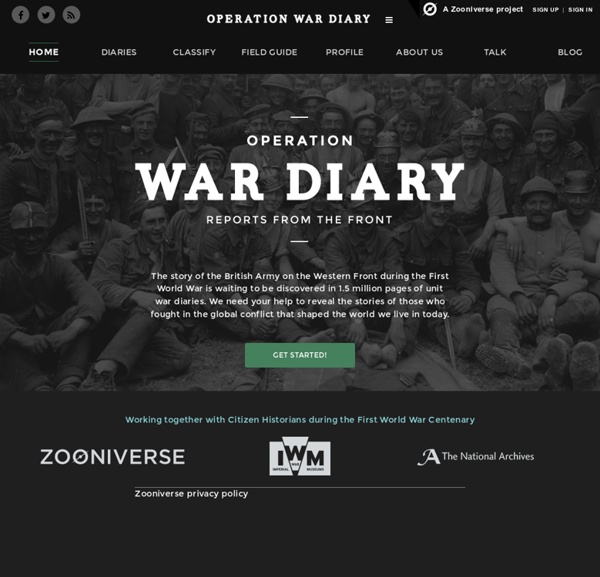



Untold Stories of the First World War Photos, letters and other memorabilia It was the war that tore Europe apart – a struggle between the central powers of Germany, Austria-Hungary, Turkey and Bulgaria, against the allied powers of Britain, France, Belgium, Russia, Italy and the USA. No European nation was left untouched – even neutral states felt the impact of the war. Renowned historian and WW1 author Peter Englund said: “This important and imaginative project tells the other side of the story, from the point of view of a young soldier who signed up seeking adventure, to the family devastated by news that he was one of millions who would never return.
Historial de la Grande Guerre Europeana Collections 1914-1918 - You are the Fleet Admiral of the Navy in WWI what do you do? The Situation You’re the Fleet Admiral of the Navy in World War I. Your ships are being sunk at an alarming rate by the devastatingly effective German U-Boat. This is the German U-Boat Sinking your Battleships The Insight It’s not where you are it’s where you’re going World War I occurred from 1914–1918; back then sinking an enemy battleship was a three-step process: Step 1: Locate your target’s position and plot its course. *Remember this is early 20th century warfare, weapons don’t travel at the speed they do today So what’s your solution Fleet Admiral? Forget about not being seen, that only solves their first problem. British Artist and naval officer Norman Wilkinson had this very insight and pioneered the Dazzle Camouflage movement (known as Razzle Dazzle in the United States). It was cheap, effective, and widely-adopted during the War. *NOTE: Unfortunately the images are in black and white, being from the early 1900s and all, so the loud, bold colours will require a little imagination.
Digitised Manuscripts Almost 900 Greek manuscripts and some of the most important papyri, ranging in date from the first to the 18th centuries, are now included in the Digitised Manuscripts site. The first two phases of the Greek Manuscripts Digitisation Project were generously funded by the Stavros Niarchos Foundation and the third phase was funded by the Stavros Niarchos Foundation, the A. G. The Royal Manuscripts and Botany in British India projects have been funded by the Arts and Humanities Research Council as a part of its Digital Transformations in Arts and Humanities Theme and contributes to a package of measures aimed at developing innovative approaches to archiving, accessing and using data for research in the arts and humanities supported as a part of the additional investment to enhance the national e.infrastructure for research announced by the Government in October 2011. The Zweig Collection of music manuscripts was digitised with the support of the Derek Butler Trust.
Lives of the First World War - Home page Life In The Trenches | WW1 Facts There was nothing glamorous about trench life. World War 1 trenches were dirty, smelly and riddled with disease. For soldiers life in the trenches meant living in fear. In fear of diseases (like cholera and trench foot) and of course, the constant fear of enemy attack. Trench warfare WW1 style is something all participating countries vowed never to repeat and the facts make it easy to see why. Constructing WW1 Trenches The British and the French recruited manpower from non-belligerent China to support the troops with manual labour. 140,000 Chinese labourers served on the Western Front over the course of the First World War (40,000 with the French and 100,000 with the British forces). No Man’s Land The open space between two sets of opposing trenches became known as No Man’s Land because no soldier wanted to traverse the distance for fear of attack. The climate in France and Belgium was quite wet, so No Man’s Land soon became a mud bath. Hell on Earth
Bienvenue à la Bibliothèque nationale et universitaire de Strasbourg The Great War Archive Happy Valentine's Day My Angel last night I received a letter from you. I learned how strong was the pain on the day we had to separate. Do you remember those beautiful kisses? Do you remember the last one we gave each other between the tears. This moving love letter was sent by Sergeant Major Giuseppe Castellani, to his wife Antonia at home in Fossato di Vico, while he was away serving in the Italian army during the First World War. Images: "Memory of our glorious Alps" sent 19 September 1917, and reverse View the full story and the images here. Words by Alun Edwards and Monica Rossi, University of Oxford